|
CONTINUED
FROM PAGE 1
THE
LANGE/ FERGUSON
MAMMOTH KILL SITE
A CLOVIS CULTURE
MAMMOTH KILL BUTCHERING SITE
PINE RIDGE,
SOUTH DAKOTA 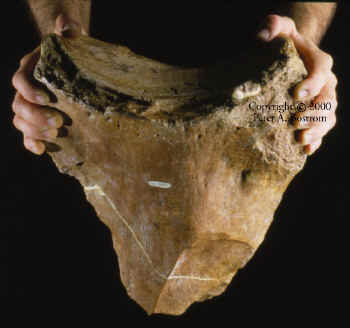
TAKEN FROM PICTURE
#15 IN THE CLOVIS SLIDE SET
CLICK ON PICTURE FOR LARGE IMAGES
CHOPPER - CLEAVER
LANGE - FERGUSON SITE
ARCHEOLOGY LABORATORY,
CENTER FOR WESTERN STUDIES, AUGUSTANA COLLEGE COLLECTION
This mammoth bone cleaver is one of the largest Clovis artifacts ever
discovered on any Clovis site. It was bifacially flaked from a segment of
the right scapula of an adult mammoth. It may have been used in the
butchering process and does exhibit secondary flaking from edge wear. This
bone cleaver weights 13 1/2 pounds (6,088 grams) and measures 13 3/16
inches long (33.5 cm).
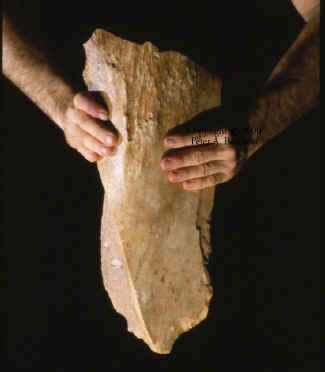
TAKEN FROM PICTURE
#16 IN THE CLOVIS SLIDE SET
CLICK ON PICTURE FOR LARGE IMAGES
CHOPPER - CLEAVER
LANGE - FERGUSON SITE
ARCHEOLOGY LABORATORY,
CENTER FOR WESTERN STUDIES, AUGUSTANA COLLEGE COLLECTION
This picture shows the second of two large mammoth bone chopper cleavers
found during the excavation of the Lange - Ferguson site. This example was
also made from the right scapula of an adult mammoth. It was bifacially
flaked into shape and use wear is apparent on the working edge. Edge wear
has been verified by scanning electron microscope examination. It weighs 7
1/3 pounds (3,302.7 grams) and measures 17 7/8 inches long (45.5 cm).

TAKEN FROM PICTURE
#18 IN THE CLOVIS SLIDE SET
CLICK ON PICTURE FOR TRIPLE EXPOSED IMAGES
FRACTURED MAMMOTH BONE
LANGE - FERGUSON SITE
ARCHEOLOGY LABORATORY,
CENTER FOR WESTERN STUDIES, AUGUSTANA COLLEGE COLLECTION
This large round flake was struck from a portion of the mammoths long
bone. The point of impact or bulb of percussion can clearly be seen at the
top right of this picture. It would have taken a single hard strike with a
hammer-stone to remove this type of flake.
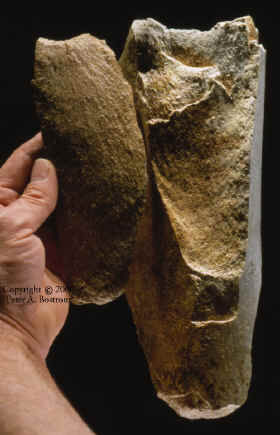
TAKEN FROM PICTURE
#17 IN THE CLOVIS SLIDE SET
CLICK ON PICTURE FOR TRIPLE IMAGE OF
FLAKE
FRACTURED MAMMOTH BONE
LANGE - FERGUSON SITE
ARCHEOLOGY LABORATORY,
CENTER FOR WESTERN STUDIES, AUGUSTANA COLLEGE COLLECTION
This picture shows a large flake and a fragment of the mammoths tibia leg
bone from which it was removed. The bone "core" was struck from
the end to remove this flake. The only logical way this fracturing process
can occur is with human interaction.
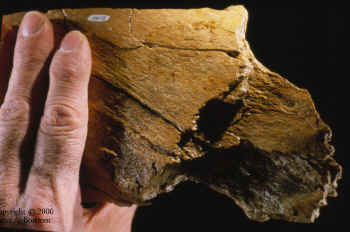
TAKEN FROM PICTURE
#20 IN THE CLOVIS SLIDE SET
CLICK ON PICTURE FOR TRIPLE EXPOSED IMAGES
FRACTURED MAMMOTH BONE
LANGE - FERGUSON SITE
ARCHEOLOGY LABORATORY,
CENTER FOR WESTERN STUDIES, AUGUSTANA COLLEGE COLLECTION
Several of the bones found on the Lange - Ferguson site were altered in
various ways by deliberate flaking. This flake from the mammoth's leg bone
measures 8 7/8 inches long (22.5 cm) and for some unknown reason was
notched in two places on one end. The mammoth bones found on this site
were some of the best preserved specimens so far discovered anywhere in
North America. Until more of these sites are discovered and excavated it
may be difficult to interpret artifacts like this example.

CLICK ON PICTURE FOR TRIPLE EXPOSED IMAGES
POINTED BONE
LANGE - FERGUSON SITE
ARCHEOLOGY LABORATORY,
CENTER FOR WESTERN STUDIES, AUGUSTANA COLLEGE COLLECTION
This mammoth bone fragment has been shaped to a point on one end. It was
done either by natural forces or by the Clovis hunters who butchered the
two mammoths found on this site.
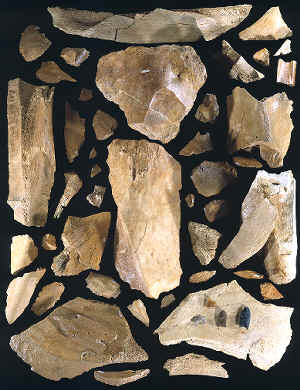
TAKEN FROM PICTURE
#14 IN THE CLOVIS SLIDE SET
CLICK ON PICTURE FOR VERY LARGE IMAGE (2
MIN.)
FRACTURED MAMMOTH BONES
LANGE - FERGUSON SITE
ARCHEOLOGY LABORATORY,
CENTER FOR WESTERN STUDIES, AUGUSTANA COLLEGE COLLECTION
PICTURE CREDIT--Pete
Bostrom
One of
the most important finds at Lange-Ferguson are the fractured bones. Some
were fractured in a way that could only have been done by humans. Many
bone beds show various types of fracturing of the bones but most can be attributed to natural
effects such as predators or large animals walking on them. This picture
shows several of the broken bones from this site. The four stone tools
found there are pictured in the lower right.
|






